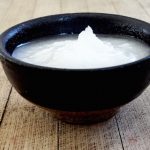We’ve been using homemade toothpaste for several months now, and are very pleased with the result. Just recently we had our annual dentist checkup—no cavities—and the doctor even diagnosed reduced inflammation of the gum.
So why are making our own toothpaste and how?
Why Do We Need To Clean The Teeth?
A very legitimate question. Surely our ancestors did not brush them, and neither does any other living being on this planet apart from humans. So why do we do it? There’s two reasons:
- Firstly, teeth are not designed to last 80+ years and neither is the rest of our bodies. Only with proper care can they last such a long time.
- But more importantly, it’s our modern carb-rich diet that troubles the teeth mostly. Bacteria on our teeth eat carbohydrates and produce organic acid that basically dissolves the enamel of our teeth.
So it’s essentially unnatural behavior that leads to tooth related problems. A healthy diet—less carbs in essence—will promote healthy teeth. Sugar is just one of many hazards.
How Does Toothpaste Protect Our Teeth?
There’s three main factors of a good toothpaste that allow for a proper and effective tooth care:
- A toothpaste should have a mild abrasive factor for removing plaque and polishing the teeth.
- Remineralization of the teeth is another one. Polishing can remove some enamel which should be remineralized.
- An antibacterial effect is the last major factor for tooth decay prevention.
Other less important factors include: flavor, even distribution of the paste and nutrients.
Some Facts About Modern Toothpastes
Did you ever wonder where the sweetness and flavour in toothpastes comes from, or why it is so white (or colorful), why is it foamy, and how does it actually clean our teeth?
Fluoride
Most toothpastes that we buy in the shop contain a lot of synthesised fluoride. It can protect our teeth from demineralisation, and can also remineralise them again. It does not get rid of the bacteria in the mouth though. But what is fluoride actually? It’s a poison. Did you ever see somebody with white streaks or specks on their teeth? That’s caused by fluoride. Overconsumption can lead to massive bone-related problems. It can even go so far as to the point of altering the hormonally controlled calcium production. Especially children are heavily affected by fluoride. Yet our dentist even suggested us to feed our child fluoride pills. Most child-toothpastes contain it, although in lesser concentrations than adults toothpastes. Our body absorbs fluoride through the mouth. But even worse, most children do not spit, they swallow it. Well, no wonder if they taste like strawberry.
So why will most dentists tell you that you need fluoride, if it is so bad? Well, it’s considered common knowledge. It’s what is official taught in universities. From a purely tooth-focused perspective, fluoride is good.
One more thing, teeth actually remineralise themselves, naturally, by producing hydroxyapatite. Though less effective than fluoride.
Sweetness, Color, Flavor
Common toothpastes are sweet, colorful and flavorful, because they contain artificial sweetener, color and flavor. There is really not much natural in there. Most of these ingredients are just beneficial for outlook and taste, but definitely not health.
Foam
Why does toothpaste foam in the mouth? The foam is produced from surfactants in the paste that are meant to help to distribute the paste more evenly on the teeth, thereby improving the cleansing effect. A common foaming agent is Sodium Lauryl Sulfate (SLS) which is considered safe, though side-effects have been reported. We believe that the benefits of the foaminess do not overweight the risks and potential hazards reported by the ingredients.
Cleaning
Now to the actual cleaning of the teeth—and this is the most interesting part of all. Most of the cleaning is actually achieved by the mechanical action of the toothbrush, and not by the toothpaste. In other words, brushing the teeth with or without toothpaste has an almost equally good cleaning effect. Though the abrasive factor of a toothpaste does benefit cleaning a little. And of course the anti-bacterial effect of the paste is very important as well.
Home Made Toothpaste
Okay, that was a quick lesson in tooth care. It is important to understand how tooth care works and why it is important in order to be able to make your own toothpaste. For us it was quite an eye-opener.
A quick recap, a toothpaste should be abrasive, remineralize the teeth and have an antibacterial effect. These three factors can actually be achieved with one single natural ingredient. Pure Natron.
- For tooth-care Natron is commonly used for it’s great abrasive effect, which helps to remove plaque and whitening the teeth.
- Further Natron has an antibacterial effect.
- Most interestingly though—and most people actually don’t know this—saliva naturally and constantly remineralizes your teeth. Natron being a salt, increases saliva production and therefore increases the remineralization effect while brushing.
So basically just dip your brush in some Natron and you’re good to go. Well, some people think that the abrasive effect of pure Natron is too strong, and will eventually wear off the enamel, this is the reason for the whitening effect of Natorn. Also the flavor can surely be improved. We recommend to crush the Natron with a mortar, which also helps to decrease the abrasive effect.
Homemade Toothpaste Recipe
After some experimenting we finally found a simple recipe that we love:
- 1/4 grated Natron
- 1/4 grated Xylitol
- 2/4 Coconut oil
Mix everything together and done.
- The benefits of Natron have already been mentioned before.
- The coconut oil absorbs toxins and bacteria from your gums and teeth (see also oil-pulling).
- Xylitol has as strong antibacterial effect and gives the whole mixture a great taste.
Optionally you can add some mint essence to make it taste like the toothpaste you’d buy.
After some weeks of daily usage of this homemade toothpaste—in combination with daily Xylitol mouth rinsing, we noticed that the color of our tongues and gum turned light pink, which is good.



